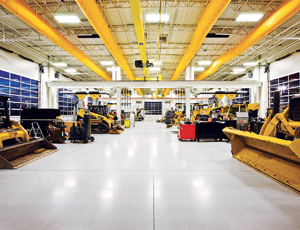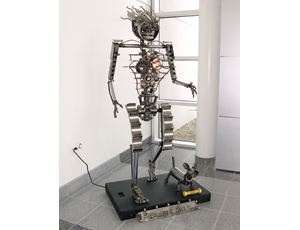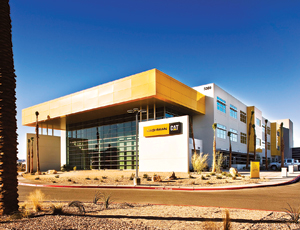Cashman Equipment Co., Nevada’s Caterpillar dealer, recently inaugurated its new multimillion-dollar headquarters in Henderson, 15 miles southwest of Las Vegas. The timing could not be worse. Peoria, Ill.-based Caterpillar’s fourth-quarter profit dropped 32% from a year ago, prompting over 20,000 job cuts amid reduced demand. Cashman, a privately held dealer with seven locations statewide, similarly trimmed its workforce by 63 people, or 8%, in December.



Despite this setback, Cashman’s new $120-million complex touts the latest in sustainable building practices and could signal the future of heavy-equipment dealerships. The project is seeking a LEED Gold certification from the U.S. Green Building Council. If successful, it would become one of only a handful of Cat dealers to achieve a LEED rating.
Grimy to Green
Cashman’s 53-acre campus goes a long way to clean up the image most people might conjure up of a greasy machine shop. It uses a geothermal heating-and-cooling system that reduces energy costs by 45%. The system’s 359, 4-in.-dia. wells rely on southern Nevada’s constant 75°-80°F underground temperatures for efficient year-round heating and cooling. Water is circulated through 65 miles of flexible pipe in a closed loop grouted into each of the 400-ft-deep wells.
"All seven buildings are tied into the geothermal well system and distributed back out through the central plant to individual buildings," says Curt Carlson, a principal with SH Architecture, the project’s Las Vegas-based architect. "The building systems eventually pay for themselves."
Built by Las Vegas-based general contractor Burke & Associates, the seven buildings have a combined 308,000 sq ft. The new facility is five times larger than Cashman’s previous North Las Vegas headquarters, where it had conducted business since 1981.
About 88% of construction waste was recycled, preventing 814 tons from going to a landfill, and the project’s 460 concrete tilt-up wall panels were mixed with 15% fly-ash content. The largest panel, 64 ft by 25 ft, weighs 200 tons. Shop floors feature a 6,000-psi, 8-in.-thick concrete slab with a diamond-hard finish created from metal shavings. It prevents chipping or denting under constant pounding of track-type tractors and sheeps-tooth compactors.
The sustainable construction came with a 6% cost premium, but is expected to pay for itself within seven years through reduced operating costs. "It’s an upscale industrial project that uses several sustainable components to create an environmentally conscious campus that leads by example," says Roger Thomas, Burke’s senior project manager. "It makes a statement about the company’s commitment to the community as well as its people." The campus will use 30% less water than a similar-sized project through efficient irrigation, low-flow plumbing fixtures and automated faucets.
The campus boasts more than one acre of repair-and-service areas, all of which feature bright, sunlit spaces with reflective-white concrete floors, white walls and roll-up doors with transparent plexiglass windows. The 20-service-bay shop has 40 "Solatubes," which are like cylindrical skylights. Measuring up to 36 in. dia., they concentrate natural daylight for electricity-free illumination. More than 90% of occupied spaces incorporate natural daylight, thanks to 3,500 panes, or one acre of high-performance glass.
The shop also sports floor- and roof-mounted cranes, rated from 1 to 17 tons, plus engine and transmission dynamometers that measure mechanical power. Grease, oils and other hazardous liquids are safely captured, filtered and recycled. An outdoor wash rack uses recycled, filtered water stored in a 2,000-gallon, on-site tank. Repair and parts areas are cooled using fabric ventilation socks, as opposed to evaporative coolers and mechanical ducts, for even air flow and laundry-machine washable cleaning. The socks require 60% less time to hang than traditional duct work. Cashman’s 22,000-item parts warehouse is two-and-a-half times larger than its previous, 28-acre facility. The inventory is tracked with bar codes.
Cashman’s replacement campus boasts other green-building items seldom seen at construction-machinery dealerships, including 12 acres of vegetated open space and public art sculptures, per a city mandate. Created by shop welders Shon Parks and Tim Moriarty, one sculpture is called "Remann and His Dog, Bolt," made from 100% Cat parts and a personification of Cat’s position as the world’s largest remanufacturer—or industrial recycler—of heavy machinery.
Cashman is just one of many employers now turning to clean, green construction. Annual start values in the market shot up five-fold between 2005 and 2008, increasing from $10 billion to as much as $49 billion, reports McGraw-Hill Construction, like ENR, a unit of the McGraw-Hill Cos. The market could triple in size by 2013, reaching up to $140 billion in construction spending.
The 78-year-old dealer, founded by James "Big Jim" Cashman to provide tractors to Hoover Dam, is building an 18,000-sq-ft rental store, to open in June, on the site of its former home.

Post a comment to this article
Report Abusive Comment